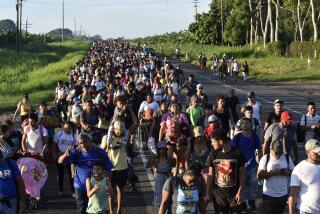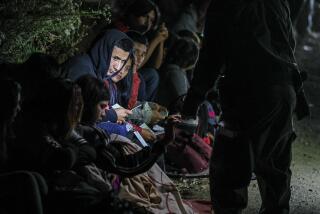Hundreds of Ukrainians are waiting in Tijuana to request protection in the United States

Near the San Ysidro Port of Entry, volunteers are working around the clock to support Ukrainian families and organize them for Customs and Border Protection to process.
- Share via
A bus stop near the entrance to the San Ysidro Port of Entry in Tijuana has filled with hundreds of Ukrainians waiting to request protection in the United States after fleeing Russia’s invasion of their country.
Ukrainian- and Russian-speaking volunteers from the United States are there working around the clock to support the group of mostly families while they wait. Those volunteers have also created a numbered list — similar to the notebook used before the pandemic to queue asylum seekers in Tijuana waiting to request protection at the port — to keep track of who should be taken to the border next when Customs and Border Protection says officials are ready to process more people.
The agency did not respond to a request for comment on the situation in time for publication.
A Trump-era policy that has continued under the Biden administration, invoking Title 42 of the United States Code, has blocked most asylum seekers from requesting protection at ports of entry. Officials said that policy was to slow the spread of COVID-19, though that reasoning has been contested since early in the pandemic.
Since public outcry in early March over one family fleeing the war being turned away at the border, Customs and Border Protection has been exempting Ukrainians from Title 42. This week, the agency’s processing also sped up considerably as many Ukrainians spent less time detained at the port before being given one-year permits to be in the United States and walking out to waiting volunteers.
Inna Levien, a mother from Orange County who belongs to a group that is coordinating the volunteer effort, said most of the Ukrainians are flying through Mexico City. Volunteers are trying to coordinate flights so the area by the port of entry doesn’t get too crowded.
Levien said it takes roughly 34 hours from when families arrive at the bus stop from the Tijuana airport for their turn to go in. She wishes it were faster.
“We don’t have enough people through the border,” she said.
Levien moved about the bustling and growing camp, giving instructions about blankets that had just returned from being washed. Someone in a car handed her a stack of pizzas to distribute.
About 600 people crossed the border before the volunteers started giving out numbers, she said. Each adult gets a number, but children do not, according to waiting families.
By late Thursday, the list was up to 718, with 180 already crossed off after going in. Sometimes, Levien said, the volunteers will move a family up in the queue because of an urgent medical need.
More Ukrainians were expected to arrive Thursday night at the airport and throughout the weekend, where volunteers pick them up and bring them to the bus stop to get added to the list.
A woman with a family of 10 told the San Diego Union-Tribune that they were on their second day of waiting. The group sat on the grass behind the bus stop, some in camping chairs and others lying on blankets on the ground.
At night, the woman said, they had been able to sleep and shower at a church.
Levien said Calvary Chapel in Tijuana had opened its doors to provide 60 beds for the Ukrainians. Another church had offered 20 beds.
It wasn’t enough for everyone, Levien said, but it helped get some of the families with the youngest children out of the cold night air. She and other volunteers are trying to find more places for the families to sleep at night while they wait in Tijuana.
For now, other families sleep on the grass or inside the bus stop. One of the families inside the small rectangular building said, through a U.S. citizen relative who had traveled from across the country to be with them in Tijuana, that they too were on their second day outside the port of entry. The relative asked not to be identified because of concerns about harassment from officials when crossing back to the United States.
She was especially concerned about young children in the group getting sick from sleeping on the cold concrete.
Once it’s their turn to go in, the newly arrived Ukrainians are processed by Customs and Border Protection in a matter of hours, and they walk out of the port of entry to where more volunteers are waiting to help them.
Levien, who emigrated from Belarus to the United States decades ago, said she felt she needed to help when she saw what was happening in the region.
Volunteers with language skills to communicate easily with the waiting families have been essential to the work. Levien said that because many of the families don’t speak English or Spanish, some businesses were taking advantage of them as they began arriving in the border city after fleeing the war.
One of those volunteers, David Miramontes of San Diego, said he felt compelled to help because of the time he spent in Ukraine working with the Peace Corps. He switched fluidly from English to Spanish to Ukrainian and Russian trying to address needs of the waiting families.
He said many of the families told him that they’d found out via the messaging app Telegram that if they could reach Tijuana, they would be welcomed into the United States, where most have loved ones waiting to receive them.
That reality contrasts sharply with how asylum seekers of other nationalities — or even Ukrainians who arrived in earlier weeks after the invasion began — have been treated at the border.
Non-Ukrainians who do manage to enter and request protection at the San Ysidro Port of Entry often spend days in holding cells in the basement before being released into the United States or sent to immigration detention centers. That used to be the process for Ukrainians as well.
The U.S. Centers for Disease Control and Prevention announced Friday that the Title 42 policy would end May 23, but it is not yet clear whether other asylum seekers will be processed in the coming months the way that the Ukrainians are now.
Morrissey writes for the San Diego Union-Tribune.
More to Read
Sign up for Essential California
The most important California stories and recommendations in your inbox every morning.
You may occasionally receive promotional content from the Los Angeles Times.











